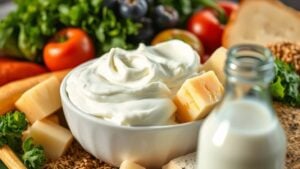Dairy could appear like a harmless part of the diet, but for many, it may be playing a sneaky role in unwanted breakouts. Scientific studies have linked milk and other dairy products to acne, largely due to certain hormones that can increase oil production and inflammation in the skin. Grasping this connection can feel overwhelming, yet there are effective dietary solutions that can help. Through exploring these options, individuals may just uncover a clearer path to healthier skin. Curious?
Understanding the Link Between Dairy and Acne
While traversing the intricate connection between diet and skin health, one factor that frequently arises is dairy intake and its possible influence on acne formation. Research indicates that dairy products, especially milk, could contribute to acne due to hormones like IGF-1, which can increase sebum production.
In fact, adolescents consuming dairy pull their odds of developing acne higher through 24%. Additionally, the proteins found in dairy can trigger pathways that promote keratinocyte proliferation and sebaceous gland activity, both crucial in acne development.
Notably, fermented dairy items like yogurt exhibit a weaker link, likely due to reduced IGF-1 bioavailability. Grasping these mechanisms can enable individuals to make informed dietary choices for improved skin health. Furthermore, lactase enzyme deficiency can lead to digestive issues such as bloating or diarrhea, potentially complicating skin conditions like acne.
The Science Behind Dairy’s Effect on Skin Health
Grasping the ever-changing interplay between dairy consumption and skin health uncovers fascinating revelations about how certain foods can affect acne. Research indicates several mechanisms through which milk and dairy products might exacerbate acne vulgaris, a common skin condition.
- Hormonal Changes: Dairy consumption increases insulin-like growth factor 1 (IGF-1), leading to heightened oil production.
- Inflammatory Pathways: Casein and whey proteins found in dairy can trigger inflammation, worsening acne severity in susceptible individuals.
- Insulin Secretion: The presence of hormones like progesterone and testosterone precursors in milk could stimulate oil glands, resulting in clogged pores.
Furthermore, the impact of high insulin levels on sebum production reinforces the connection between dairy and acne prevalence, emphasizing the need for further exploration of dietary impacts on skin disease and comprehensive health.
Five Dietary Solutions to Combat Acne
At times considering dietary solutions for acne, it’s vital to acknowledge that food choices can play a central role in skin health. One effective approach is adopting a low-glycemic diet, which reduces acne lesions through stabilizing insulin levels and decreasing sebum production.
Eliminating dairy, particularly skim milk, can lower IGF-1 levels, reducing hormonal triggers tied to acne. Increasing omega-3 fatty acids via fish or algae not only fights inflammation but can reduce inflammatory acne by 40%.
Zinc supplementation also shows promise, as it decreases acne severity markedly. Finally, integrating probiotics from sources like kimchi and kefir can improve gut-skin health, reducing flare-ups through improved microbiota balance and lowered systemic inflammation. Incorporating fermented dairy products may also provide beneficial bacteria that improve gut health and promote better skin.
Exploring Plant-Based Alternatives to Dairy
As many seek dietary solutions for acne, exploring alternatives to dairy becomes an appealing option. Plant-based alternatives offer a variety of benefits while avoiding potential acne triggers like IGF-1 hormones and high glycemic indexes. Some notable options include:
- Almond milk: Naturally lactose-free and provides 50% more calcium than cow’s milk.
- Soy milk: Contains 7g of protein per cup without the acne-inducing hormones found in dairy.
- Oat milk: Its beta-glucans can reduce inflammation through a 22% reduction, helping to mitigate acne flare-ups.
Additionally, coconut yogurt includes lauric acid to fight acne-causing bacteria, and pea protein milk delivers 8g of protein while maintaining a low glycemic index to avoid insulin spikes.
Together, these options create a more pimple-friendly diet.
Monitoring Insulin and Hormonal Balance for Clearer Skin
While maintaining balanced insulin and hormones can feel overwhelming, grasping this connection is vital for achieving clearer skin. Research reveals that dairy products can spike insulin levels and increase IGF-1, leading to excessive sebum production and inflammatory acne.
Following a low-glycemic diet can help stabilize blood sugar, reducing insulin resistance and lowering IGF-1 levels through a 20-30% decrease. This shift can effectively minimize acne flare-ups by decreasing sebum production.
Additionally, integrating fiber-rich foods, such as leafy greens and legumes, into daily meals can assist in maintaining hormonal balance. These dietary adjustments support clearer skin by reducing inflammatory lesions and tackling the root causes of hormonal acne.
Monitoring these factors is essential for skin health and general wellness.


